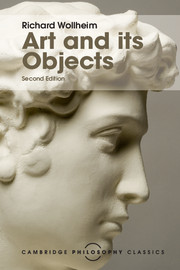Book contents
- Frontmatter
- Dedication
- Contents
- Preface to this edition
- Preface to the second edition
- The argument
- Art and its objects
- Supplementary essays
- 1 The Institutional theory of art
- 2 Are the criteria of identity for works of art aesthetically relevant?
- 3 A note on the physical object hypothesis
- 4 Criticism as retrieval
- 5 Seeing-as, seeing-in, and pictorial representation
- 6 Art and evaluation
- Bibliography
5 - Seeing-as, seeing-in, and pictorial representation
from Supplementary essays
Published online by Cambridge University Press: 05 November 2015
- Frontmatter
- Dedication
- Contents
- Preface to this edition
- Preface to the second edition
- The argument
- Art and its objects
- Supplementary essays
- 1 The Institutional theory of art
- 2 Are the criteria of identity for works of art aesthetically relevant?
- 3 A note on the physical object hypothesis
- 4 Criticism as retrieval
- 5 Seeing-as, seeing-in, and pictorial representation
- 6 Art and evaluation
- Bibliography
Summary
In Art and its Objects I made two claims about pictorial representation. The first claim was that representation (as I shall call it for short) is to be understood through, though not exclusively through, a certain species of seeing, which may be thought of, but not, of course, defined, as the seeing appropriate to representations. Representation is not to be understood exclusively in these terms: at least for the reason that reference is also required to artifactuality. The second claim was that the seeing appropriate to representations is a species of a broader perceptual genus, for which I used – confusingly, I now recognize, but I shall stick to it – the term ‘representational seeing’. The present essay amplifies the second of these two claims.
The nature of the perceptual species, or what is unique to the seeing appropriate to representations, is easier to characterize than the nature of the perceptual genus to which the species belongs, or what is common to all representational seeing. What is unique to the seeing appropriate to representations is this: that a standard of correctness applies to it and this standard derives from the intention of the maker of the representation, or ‘the artist’ as he is usually called – a practice harmless enough, so long as it is recognized that most representations are made by people who neither are nor claim to be artists. Naturally the standard of correctness cannot require that someone should see a particular representation in a particular way if even a fully informed and competent spectator could not see it that way. What the standard does is to select the correct perception of a representation out of possible perceptions of it, where possible perceptions are those open to spectators in possession of all the relevant skills and beliefs. If, through the incompetence, ignorance, or bad luck of the artist, the possible perceptions of a given representation do not include one that matches the artist' intention, there is, for that representation, no correct perception – and consequently (to invoke the first of the claims made in Art and its Objects) nothing or no-one represented.
The standard, it will be observed, applies both to representations of particular things and to the representations of things of a particular kind as the following examples bring out.
- Type
- Chapter
- Information
- Art and its Objects , pp. 137 - 151Publisher: Cambridge University PressPrint publication year: 2015
- 16
- Cited by



